There are 50 native snakes in New Mexico, but there are only two types of venomous snakes. They are Rattlesnakes and Coral Snakes.
They are mainly found in the southwestern regions of the state. While snake bites in New Mexico are quite a rare occurrence, happening about 100 times yearly due to rattlesnakes, there are about 5 fatalities due to bites out of several thousand.
It is rare for rattlesnakes or coral snakes to bite since they are hard to spot and will only do so in defense or if they are messed with. You best not approach or startle them if you run into one.
In New Mexico, it is legal to import venomous snakes without a permit since snakes are not protected by federal or state laws. It is legal to kill, harvest anywhere from 5 to 30 snakes with limitations depending on the species.
However, it’s illegal for anyone to take any New Mexico native snake from the wild for commercial purposes without a commercial collecting permit.
Now that we’ve gotten the basics and laws for snakes in New Mexico down, let’s get right into what kind of snakes you can find in this state.
Table of Contents
Common Snakes in New Mexico
Here are some common snakes that roam the state:
1. Glossy Snake

- Experience Level: Beginner
- Family: Colubridae
- Scientific Name: Arizona elegans
- Other Names: Faded Snake
- Adult Size: 30 to 50 inches
- Lifespan: 10 to 18 years
- Average Price Range: around $40 per snake
These slow-slithering, nocturnal beings look very similar to gopher snakes with pointed, narrow heads and similar coloration.
They have tan to light brown bodies with a faded look, hence their names, and brown blotches all throughout their length. Their undersides are typically cream or pale yellow in color and they have shiny-looking scales, giving them an almost glossy finish.
They are fairly large in size and are pretty easy-going, making them good pets as well.
They like to inhabit dry areas such as grasslands, deserts, sagebrush, chaparral, and pine-juniper.
They mainly feed on vertebrates such as lizards, rodents, smaller snakes, smaller birds, and sometimes insects. They consume their prey by constricting them with their tight grip, suffocating them, then eating them whole.
2. Black Racer
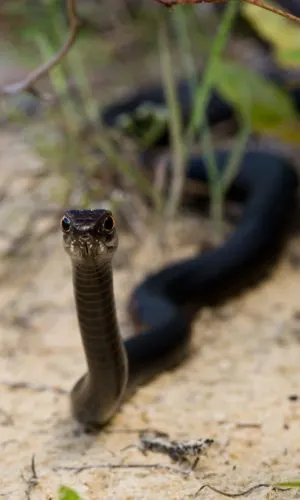
- Experience Level: Intermediate
- Family: Colubridae
- Scientific Name: Coluber constrictor constrictor
- Other Names: Northern Black Racer
- Adult Size: 33 to 65 inches
- Lifespan: 10 years
- Average Price Range: about $40 per snake
Although Northern Black Racers are non-venomous, they are sometimes a little bit aggressive when defensive. As long as you don’t startle or corner it, it will not deliberately try to attack you.
Black racers do not usually feel threatened by humans but you should still not give it a reason to use self-defense. A bite can still be painful and susceptible to infection regardless of whether or not there is venom.
When threatened, they will raise their head.
As far as these snakes go as pets, they are not particularly docile and will only rarely become accustomed to being handled. Black racers also like to travel a lot over long distances, making them unsuitable for a tank or terrarium habitat.
Northern Black Racers have large, long, slender, solid black, round bodies with a white chin and a faded blue underside. They have smooth, matte-looking scales and a head that is almost the same width as their body.
Some black racers may be blue-gray, brown, dark gray, or rust-colored with blotches on their back as well.
You can find these snakes in habitats that are brushy such as grasslands, old fields, rock ledges, ridges, and agricultural fields.
They prey on toads, frogs, small birds, rodents, and smaller snakes. They may also sometimes feed on insects and invertebrates like moth larvae or butterflies.
3. Northern Trans-Pecos Rat Snake

- Experience Level: Beginner
- Family: Colubridae
- Scientific Name: Bogertophis subocularis subocularis
- Other Names: Trans-Pecos Rat Snake, Davis Mountain Rat Snake, Transpecos Ratsnake
- Adult Size: 36 to 54 inches
- Lifespan: 10 to 15 years
- Average Price Range: $100 to $200 per snake
The Northern Trans-Pecos Rat Snake can only be found in very few places, New Mexico being one of them. Trans-Pecos Rat Snakes are hard to spot in general since they only occur in specific areas.
These snakes usually range from a tan-orange or yellow to a light olive-colored body with keeled scales and H-shaped brown blotches throughout their back. You might also find dark brown or black stripes on them as well.
The Trans-Pecos Rat Snake chooses to inhabit dens like outcrops of rocky areas, slopes with brushes, and desert flats.
They feed on smaller lizards, birds, and rodents. When captive, they can live off of rodents.
4. Red-tailed Green Ratsnake

- Experience Level: Intermediate
- Family: Colubridae
- Scientific Name: Gonyosoma oxycephalum
- Other Names: Arboreal Rat Snake, Red-tailed Racer, Red-tailed Tree Snake
- Adult Size: almost 8 feet
- Lifespan: 20 years
- Average Price Range: $150 to $300 per snake
Since these species are arboreal, keeping them as a pet will require a taller set up to accommodate their natural climbing needs.
Red-tailed Green Rat Snakes are very long, slender snakes. They are commonly green with black coloration between scales, which will show more prominently when they are acting out defensively.
Despite the name they were given, their tails are commonly a more grayish-bluish or lavender in color, although some are actually red. They also have bright blue tongues.
You can find them roaming in tropical forests like swamps, mangroves, bamboo, or riverine forests. They are actually native to Southeast Asia, where tropical forests are abundant.
In their natural habitats, they almost exclusively eat bats, birds, and their eggs. These arboreal snakes will hang from the branches and catch their prey mid-air, constricting them, then eating them whole.
Since they are natural climbers, they can also find their way into birds’ nests to feast on their young.
5. Sonoran Whipsnake

- Experience Level: Expert
- Family: Colubridae
- Scientific Name: Masticophis bilineatus
- Other Names: Sonoran Mountain Whipsnake
- Adult Size: Up to 6 feet
- Lifespan: About 15 years
The Sonoran Whipsnake is a feisty one and quick to bite if you attempt to approach one. They are quite aggressive, which makes them unsuitable for captivity.
They have long and slender olive or gray-blue bodies that fade into yellow toward their tail. They also have a few lighter-colored stripes on each of their sides.
This species has a broad head with large, round yellow eyes and round, black pupils. They have seventeen rows of smooth scales that reach a divided anal plate.
You can find these Whipsnakes in foothills, rocky canyons, mountains with lots of thick vegetation, thorny desert brushland, mountain pine-oak forests, riparian areas, or anywhere with shrubs, cottonwood, juniper, pine-oak forests, palo verdes, and open areas near streams.
They tend to be found in elevations of around 2,000 to 6,000 feet.
They enjoy feasting on lizards and birds but particularly like their nestlings.
6. Coachwhip

- Experience Level: Expert
- Family: Colubridae
- Scientific Name: Coluber Masticophis flagellum
- Other Names: Whipsnake
- Adult Size: 5 to 8 feet
- Lifespan: 16 to 20 years in captivity; Wild lifespan: 13 years
- Average Price Range: about $50 per snake
Coachwhips are thought to be some of the quickest snakes in America. They are also among the longest snakes in the region.
Coachwhips are fairly slender with distinctive black or dark brown head and ombre colorations with lighter browns and tans down their backs toward their tail.
They have large eyes, which give them great vision as they swiftly sweep the terrain for prey.
You can find them in any dry terrain such as prairies, farmlands, deserts, shrublands, juniper grasslands, creek valleys, and chaparral. You might also find them roaming around agricultural areas with vegetation.
They eat a diet of mainly rodents, frogs, lizards, birds and their eggs, spiders, and even small venomous snakes. They are also known to eat rattlesnakes if they happen to cross paths with one.
7. Desert Striped Whipsnake
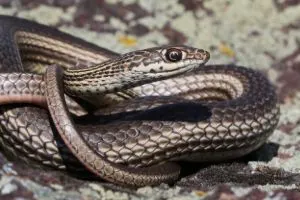
- Experience Level: Expert
- Family: Colubridae
- Scientific Name: Coluber Masticophis taeniatus taeniatus
- Other Names: Striped Whipsnake
- Adult Size: 24 to 67 inches
- Lifespan: anywhere from 10 to 20 years
Desert Striped Whipsnakes are typically black, dark brown, or gray in color with a blue or olive tint to their skin. They have two pale yellow stripes along their backsides all throughout their length.
Their undersides are usually pale yellow or cream from the head fading into a coral red toward the tail.
They can be found in various habitats such as grasslands, canyons, sagebrush flats, shrublands, pine-oak forests, and juniper woodlands. However, they typically prefer rocky streams, mountains, and flatlands.
This species of snake eats smaller mammals, birds, their eggs, amphibians, other snakes including rattlesnakes, and insects.
8. Ringneck
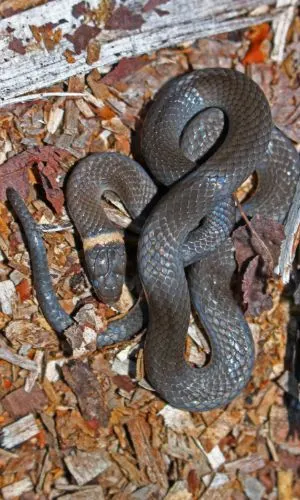
- Experience Level: Intermediate
- Family: Colubridae
- Scientific Name: Diadophis punctatus
- Other Names: Ring-necked Snake
- Adult Size: 10 to 15 inches
- Lifespan: 20 years in the wild; 6 years in captivity
Ringneck Snakes have slender bodies and smooth scales, ranging from black, bluish-black, greenish-gray, to olive in color. Their undersides will usually be yellow, orange, or red.
You can find these snakes in wide varieties of habitats as long as there is a lot of places for them to hide and take cover. They like making dens under woody debris.
They mainly feed on terrestrial worms, mollusks, and amphibians.
9. Chihuahuan Hooknose Snake

- Experience Level: Unknown
- Family: Colubridae
- Scientific Name: Gyalopion canum
- Other Names: Western Hooknose Snake, Chihuahuan Snake, Hook-nosed snake
- Adult Size: 15 inches
- Lifespan: Unknown
Hooknose Snakes are quite interesting because they have similar noses to a Hog-nosed, except it is a bit more upright and sharp. They also make little clicking or some say it sounds like tooting noises.
Check out this cool video of one here where you can hear the noises they make in defense of a threat:
These snakes are usually gray or gray-brown in color with dark brown blotches all the way down their back and smooth scales. Their undersides are cream or pale yellow.
As their name suggests, they have an upturned snout, similar to the Hognose.
These snakes are nocturnal burrowers, which is why they are more often found under rocks. They like to live in sandy habitats near a good water source.
Their diet consists mostly of arthropods like spiders, scorpions, and centipedes, but they will also consume smaller snakes, lizards, and other reptile eggs.
10. Mexican Hog-nosed Snake

- Experience Level: Beginner
- Family: Colubridae
- Scientific Name: Heterodon kennerlyi
- Other Names: Mexican Hog-nosed Snake, Mexican Hognose Snake
- Adult Size: 17 to 24 inches
- Lifespan: 12 to 20 years
- Average Price Range: $100 to $500 per snake
The Mexican Hognose Snake has light tan, but sometimes orange, skin with blurry-looking brown blotches that turn into stripes as the patterns reach the tail. Their undersides have a black checkered pattern and are usually light orange in color.
You can find them in sandy habitats like a scrub, grasslands, gravelly prairies near streams, dry mountain canyon basins, open riparian woodland, and refined caves.
They will mostly feed on lizards and rodents, but will also eat frogs. They have immunity to any toxins these toads might secrete as well, allowing them to feast comfortably.
11. Plains Hognose Snake

- Experience Level: Beginner
- Family: Colubridae
- Scientific Name: Heterodon nasicus
- Other Names: Hognose snake
- Adult Size: 15 to 25 inches
- Lifespan: about 10 to 15 years
- Average Price Range: $100 to $500 per snake
The Plains Hognose snake is known to be one of the best pet snakes for enthusiasts since they are not fussy and are comfortable with human interaction.
They also stay relatively small and have a cute, lovable face with their tiny snout, as their name suggests.
These worm-like snakes have a small snout and a pug-like face. They are usually a light yellow or tan color with a brown spotted pattern throughout their bodies.
They are known to be pretty easy to care for in terrariums and come from dry environments with low vegetation, abundant in rocks or stones. They enjoy digging and prefer sandy areas with space to burrow.
Hog-nosed snakes like to eat frogs and toads, even poisonous ones. However, they will also feed on lizards, small mammals like birds, insects, and salamanders.
12. Eastern Hognose Snake

- Experience Level: Beginner
- Family: Colubridae
- Scientific Name: Heterodon platirhinos
- Other Names: Eastern hog-nosed snake
- Adult Size: 20 to 33 inches
- Lifespan: 12 years
- Average Price Range: $100 to $500 per snake
The Hognose snake is known to be one of the best pet snakes for enthusiasts since they are not fussy and are comfortable with human interaction. They also stay relatively small.
These worm-like snakes have a large, round head with an upward-facing snout, which is what we all love about them. They are a dark gray or olive-green, but some are also yellow, tan or light brown with dark brown spotted patterns on their head and sometimes their bodies.
They prefer to inhabit sandy woodlands, farmland, coastal areas, and fields where they feed on frogs, salamanders, invertebrates, birds, and small mammals. They can use their hog-like nose to get into their prey’s burrows more easily.
13. Texas Nightsnake
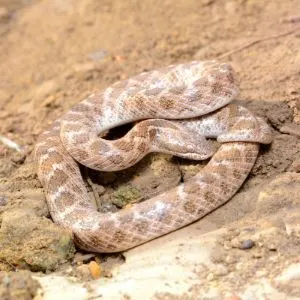
- Experience Level: Intermediate
- Family: Colubridae
- Scientific Name: Hypsiglena jani texana
- Other Names: Texas Night Snake, Chihuahuan Night Snake
- Adult Size: 26 inches
- Lifespan: 12 years in captivity; Wild unknown
You can identify these snakes with their tan or light gray color and dark brown or gray blotches. They have smooth dorsal scales and their undersides are unmarked.
They have copper eyes with a vertically elliptical pupil.
You can find them in semi-arid areas with rocky dirt or soil since that is their preference. In this habitat, they eat mostly smaller snakes and soft insects without an exoskeleton.
14. Gray-Banded Kingsnake

- Experience Level: Beginner
- Family: Colubridae
- Scientific Name: Lampropeltis alterna
- Other Names: Alterna, Davis Mountain Kingsnake, Blair’s Kingsnake
- Adult Size: 12 to 40 inches
- Lifespan: about 20 years
These beautiful snakes have a gray body with alternating orange botches with black outlines, making them looked striped.
You can find Gray Banded Kingsnakes in hot and arid habitats, mostly around rocky or mountainous environments. They like to hide in the ground or inside rocky crevices in order to cool off away from the brutal heat.
These snakes feed mainly on lizards but will eat the occasional frog, small rodents, other snakes, and ground-nesting bird eggs.
15. California Kingsnake

- Experience Level: Beginner
- Family: Colubridae
- Scientific Name: Lampropeltis getula californiae
- Adult Size: 3 to 4 feet
- Lifespan: 20 to 30 years
- Average Price Range: around $100 per snake; $200 for some morphs
Kingsnakes are some of the most commonly kept snakes as pets. They are relatively docile and don’t grow to be too large in size.
California Kingsnakes are usually black or dark brown with white or sometimes pale yellow bands. They may vary per individual, but typically, they look as if they are striped black and white or brown and yellow.
They can be found in various habitats such as grasslands, deserts, marshes, forests, coastal regions, the suburbs, and ranches most of the time hiding under debris, leaves, or finding cover under man-made structures.
California Kingsnakes really like eating meat. They often feed on rodents, but will also consume small birds, lizards, and other snakes including rattlesnakes.
They aren’t very picky when it comes to their meals and can live off only mice alone quite happily.
16. Desert Kingsnake

- Experience Level: Beginner
- Family: Colubridae
- Scientific Name: Lampropeltis getula splendida
- Other Names: Desert King Snake
- Adult Size: 5 feet
- Lifespan: 12 to 20 years
- Average Price Range: $100 to $200 per snake
Desert Kingsnakes are well-known for their black or dark brown color with yellow or white speckles all over each of their sides. They also have larger black blotches on their back lined up along their length.
You can find these snakes in open areas in which they like to roam. They mostly inhabit abandoned farms, grasslands, deserts, woodlands, and low mountains.
Their diet consists of rodents, lizards, and even other smaller snakes. They will also eat rattlesnakes if they come across one.
17. Arizona Mountain Kingsnake
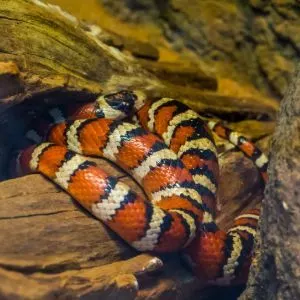
- Experience Level: Beginner
- Family: Colubridae
- Scientific Name: Lampropeltis pyromelana pyromelana
- Other Names: Sonoran Mountain Kingsnake
- Adult Size: 36 inches
- Lifespan: up to 30 years in captivity; 10 to 15 years in the wild
- Average Price Range: $100 to $200 per snake
Arizona Mountain Kingsnakes are typically red or very dark orange in color with cream blotches that have black outlines, making them appear to be striped.
If you startle them, they will emit a foul-smelling musk in self defense.
These snakes like to live in higher elevations in the mountains. They like rocky areas near streams where they can have a consistent water source.
Their diet mainly consists of lizards, rodents, and eggs of other animals.
18. New Mexico Milksnake
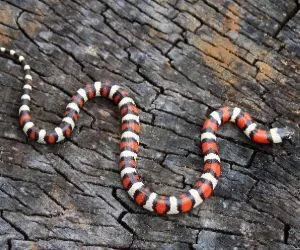
- Experience Level: Beginner
- Family: Colubridae
- Scientific Name: Lampropeltis triangulum celaenops
- Other Names: Milksnake
- Adult Size: 24 to 42 inches
- Lifespan: 20 years in captivity; about 12 years in the wild
Milksnakes are tan or brown with black-brown bands and blotches that loop around the length of their body. Their skin can sometimes be a pale yellow with almost a red striped pattern, similar to the Western Milk Snake and the venomous Coral snake, depending on the Milk Snake.
New Mexico Milksnakes like to inhabit open grasslands, old fields, and prairie habitats. They are nocturnal beings that spend their time hiding under logs and other animal’s burrows.
They feed on vertebrates such as smaller mammals, lizards, other smaller snakes, and the eggs of reptiles.
19. Plain-bellied Water Snake

- Experience Level: Beginner
- Family: Colubridae
- Scientific Name: Nerodia erythrogaster
- Other Names: Plain-bellied Water Snake, Plainbelly Water Snake, Blotched Snake
- Adult Size: 30 to 48 inches
- Lifespan: Up to 10 years in captivity; wild lifespan unknown
- Average Price Range: $20 to $80 per snake
The Plain-Bellied water snake is large, hefty, and solid in color. They will usually be green-gray, solid gray, brown, olive green, or just black in color. They can be distinguished from other water snakes by checking for their unmarked, or plain, underside which might be pale yellow or red.
They like to live in forest edges, ponds, lakes, streams, and bays where they eat fish, crayfish, tadpoles, amphibians, and salamanders.
20. Smooth Green Snake
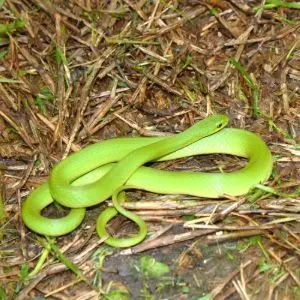
- Experience Level: Intermediate
- Family: Colubridae
- Scientific Name: Opheodrys vernalis
- Other Names: Green Snake
- Adult Size: 14 to 20 inches
- Lifespan: 6 years
- Average Price Range: $8 to $10 per snake
Smooth Green snakes can make great pets for any owner that is a little squeamish about feeding them dead rodents. These guys will mostly eat insects like spiders, moths, ants, snails, slugs, worms, and spineless caterpillars.
However, it is said that they do not make great pets since they are way too timid for human interaction. However, they are harmless and some enjoy being handled.
They can be found in open woods, stream edges, marshes, and meadows. They thrive in moist, grassy areas.
As you can already tell by their name, these snakes will be a bright green, which can range in shade. They stay relatively small and may have a pale yellow underside with beady eyes.
These are not the easiest snakes to keep captive since they are very anxious and easily stressed out.
21. Great Plains Rat Snake
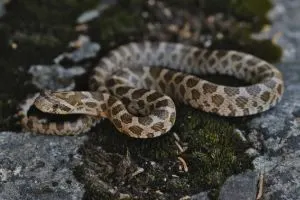
- Experience Level: Beginner
- Family: Colubridae
- Scientific Name: Pantherophis emoryi
- Adult Size: 5 feet
- Lifespan: 21 years
- Average Price Range: $50 to $100 per snake
The Great Plains Ratsnake is typically a tan or lighter gray in color with brown, dark gray, or greenish-gray blotches down its back and a light tan stripe on each side of its head that meet between its eyes.
They don’t have very large teeth and are non-venomous, but do tend to be bitey. Most of the time they are not aggressive, though.
They live in a wide variety of areas such as brushes, hill prairies, fields, canyons, barnyards, woodlands, riparian areas, and will even make homes out of abandoned houses. They like any place that they can hide under logs, rocks, boards, and even existing abandoned animal burrows.
As their name suggests, rodents will be a huge part of their diet but they also eat lizards, frogs, and birds. They will sit and wait until they see prey before they strike, constrict, and swallow their prey.
22. Northern Green Rat Snake

- Experience Level: Beginner
- Family: Colubridae
- Scientific Name: Senticolis triaspis intermedia
- Other Names: Northern Green Ratsnake
- Adult Size: 63 inches; 5.25 feet
- Lifespan: 12 to 20 years
Northern Green Rat Snakes are olive-green with a slight lime green tint to them and their undersides are cream-colored. You might find a few dark mustard yellow markings or blotches on them, but they are mostly pretty faded.
They like to inhabit grasslands and evergreen forests where they feed on small birds, lizards, and bats by constricting them.
23. Gophersnake

- Experience Level: Intermediate
- Family: Colubridae
- Scientific Name: Pituophis catenifer
- Other Names: Gopher Snake
- Adult Size: 4 to 7 feet; can reach up to 9 feet
- Lifespan: 12 to 15 years; up to 30 years in captivity
- Average Price Range: $30 to $100 per snake
The Gopher Snakes are heavy-bodied, docile creatures except when threatened.
These guys will require a very secure enclosure as they are escape artists. They also require a lot of space due to their size and active nature.
Gopher snakes are usually a light tan to brown color with large, dark brown, sometimes reddish-brown spots and lined patterns throughout their length.
They can be found in pine or oak barrens, savannas, and sand prairies where they do a great job at keeping gopher populations from overabundance.
They really like to eat small rodents, which is actually how they got their name.
24. Long-nosed Snake

- Experience Level: Expert
- Family: Colubridae
- Scientific Name: Rhinocheilus lecontei
- Other Names: Long-nosed Snake
- Adult Size: 30 to 40 inches
- Lifespan: less than 20 years
Long-nosed Snakes are not commonly found in the pet trade because they are difficult to keep since they are notorious escape artists.
They get their name from their slightly upturned, long snout somewhat resembling a shark nose.
They look very similar to a Coral Snake or Milk Snakes with their black and red-orange stripe-like pattern except Long-nosed snakes will have somewhat faded looking sides which are almost a checkered pattern of the same colors as their body. They also have a light yellow or cream-colored body, which looks like a background under other colors.
These nocturnal beings like arid environments such as deserts and dry prairies where they burrow during the day and crawl on cool roads at night.
These snakes feed primarily on amphibians and lizards but will sometimes be caught eating other smaller snakes and the occasional rodent.
25. Mountain Patchnose Snake

- Experience Level: Beginner
- Family: Colubridae
- Scientific Name: Salvadora grahamiae grahamiae
- Other Names: Patch-nosed Snake
- Adult Size: less than 4 feet
- Lifespan: 14 years
- Average Price Range: $50 to $100 per snake
Mountain Patchnose Snakes are long, slender, and tan or cream in color with two wide black or dark brown stripes down the length of their back. their undersides are typically cream-colored or off-white.
These snakes are diurnal and move swiftly throughout open arid or semi-arid climates. They prefer to inhabit grasslands, deserts, sagebrush, rocky hillsides, canyon scrub, and sandy plains.
They will typically eat whiptails along with other lizards, small mammals, smaller snakes, amphibians, birds, and reptile eggs.
26. Ground Snake

- Experience Level: Beginner
- Family: Colubridae
- Scientific Name: Sonora semiannulata
- Other Names: Western Ground Snake, Variable Ground Snake, Common Ground Snake
- Adult Size: 8 to 19 inches
- Lifespan: an estimated 15 years
Ground Snakes will vary in color depending on the individual. Some may be brown, red, or some orange. They will usually have a black banding with orange or brown blotches that look like stripes.
Their undersides are solid white or gray. They have smooth scales, round pupils, and a smaller head.
They like to inhabit arid environments that have loose, sandy soil or rocky areas like low desert shrubbery, rims of canyons, outcroppings, and slopes.
It is hard to run into these snakes since they are always hiding in debris, but they will usually come out when the sun is about to set. They have been spotted on desert roads before.
Ground Snakes eat invertebrates like spiders, centipedes, crickets, scorpions, and larvae.
27. Smith’s Black-headed Snake

- Experience Level: Intermediate
- Family: Colubridae
- Scientific Name: Tantilla hobartsmithi
- Other Names: Southwestern Blackhead Snake
- Adult Size: 8 inches
- Lifespan: Unknown
This slender snake has a light brown or tan body with a black head, as their name suggests. Their undersides are typically almost lavender in color with a red line through the middle.
They can be found in desert scrub areas, semi-desert grasslands, plains, oak woodlands, and pine-oak woodlands.
They consume caterpillars, centipedes, and beetle larvae.
28. Plains Black-headed Snake
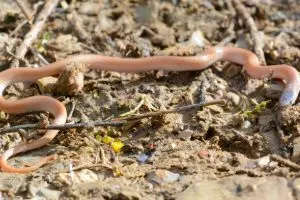
- Experience Level: Intermediate
- Family: Colubridae
- Scientific Name: Tantilla nigriceps
- Other Names: Plains Blackhead Snake
- Adult Size: 7 to 15 inches
- Lifespan: Unknown
Plains Black-headed Snake has a uniform tan to grayish-brown body with a pink-orange underside. Some may have lavender colorations on their neck and chin.
At the top of their head, they have a large black or dark blue that seemingly covers the entirety of their head, which is where they get their name.
You might find them in grassy, rocky prairies, or in hillsides with moist soil. People have even spotted them in their basements.
They mostly eat spiders and beetle larvae, but will also eat centipedes and sometimes scorpions.
29. Western Blackneck Garter Snake
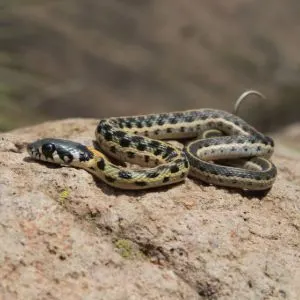
- Experience Level: Beginner
- Family: Colubridae
- Scientific Name: Thamnophis cyrtopsis cyrtopsis
- Other Names: Black-necked Gartersnake, Blackneck Garter Snake
- Adult Size: 42 inches; 3.5 feet
- Lifespan: 10 years in captivity; 4 to 5 in the wild
- Average Price Range: $50 to $100 per snake
These diurnal beings are quite active when the sun is out and can live in a wide range of temperatures and habitats. They like to bask on rocks during the winter to get some warmth from the sun.
They can live anywhere from forested mountains to arid deserts, but prefer to be near a good water source at all times no matter where they settle.
Blackneck Garter Snakes are typically dark olive or seemingly black in color with a yellow or orange stripe going right down the middle of their back. Some individuals may have a checkered black and white pattern along each of their sides. Their undersides usually are cream or light gray.
These snakes will hunt rivers for amphibians or small fish, but they will also eat other snakes, earthworms, as well as other invertebrates.
30. Wandering Garter Snake
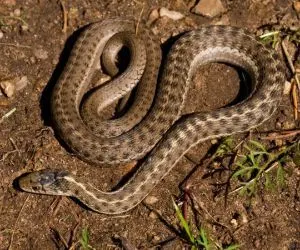
- Experience Level: Beginner
- Family: Colubridae
- Scientific Name: Thamnophis elegans vagrans
- Other Names: Western Terrestrial Garter Snake
- Adult Size: 18 to 43 inches
- Lifespan: 6 to 12 years in captivity; 2 years in the wild
Wandering Garter Snakes are typically gray or gray-brown covered in a black checkered pattern and three cream-colored stripes running down the top and sides of their body.
They prefer to inhabit riparian habitats as well as any other areas with moist climates like lakes, ponds, and wet meadows. You can also find them in sagebrush and coniferous forests.
They will hunt for fish, mollusks, tadpoles, and amphibians in water but will also eat insects like grasshoppers, as well as small vertebrates like birds, reptiles, and mice.
31. Checkered Gartersnake
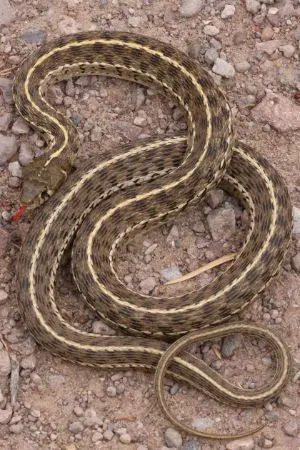
- Experience Level: Beginner
- Family: Colubridae
- Scientific Name: Thamnophis marcianus marcianus
- Adult Size: 2 feet
- Lifespan: 4 to 5 years in the wild; 10 years in captivity
- Average Price Range: $50 to $100 per snake
Checkered Gartersnakes are usually olive green or brown-green in color with a distinct checkerboard pattern on their sides as well as a pale yellow or tan stripe down the middle of the length of its back.
They can be found in arid and semi-arid habitats such as savannas, thornbush savannas, deserts, grasslands, forests, and tropical forests.
They will consume anything they are capable of overpowering such as earthworms, slugs, leeches, amphibians, frog eggs, and rodents.
32. Narrow-Headed Garter Snake

- Experience Level: Beginner
- Family: Colubridae
- Scientific Name: Thamnophis rufipunctatus
- Adult Size: 44 inches
- Lifespan: 4 to 5 years in the wild; 10 years in captivity
Narrow-Headed Garter Snakes are typically brown-gray or dark tan in color with faded brown markings that are like round blotches in a checkerboard pattern.
They are the most aquatic species of all other Gartersnakes, meaning they like to inhabit areas that have cool, clear water sources such as rivers and streams. They may also find large boulders to hide under nearby.
They can swim through strong currents to hunt for fish.
33. Arid Land Ribbon Snake

- Experience Level: Beginner
- Family: Colubridae
- Scientific Name: Thamnophis proximus diabolicus
- Adult Size: 20 and 30 inches
- Lifespan: 12-20 years
The Arid Land Ribbonsnake is typically olive green or green-brown in color with two pale yellow stripes running along their sides and a single red stripe along the top of their back.
This species is highly adaptable when it comes to their habitat, but they can mostly be found in grasslands, temperate woodland, vegetated streams, and anywhere tropical with permanent water sources like marshes, ponds, and lakes.
Since they mostly thrive in water, they will consume prey that comes near. They prefer to eat frogs, toads, amphibian larvae, and tadpoles, but they will also occasionally eat fish.
34. Plains Garter Snake
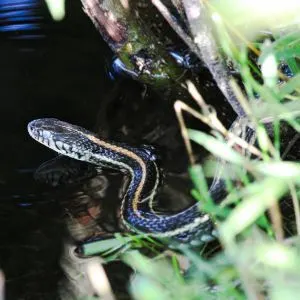
- Experience Level: Beginner
- Family: Colubridae
- Scientific Name: Thamnophis radix
- Adult Size: 16 to 28 inches
- Lifespan: 5 years; sometimes up to 8 years
- Average Price Range: $20 to $300 per snake (depending on type and size)
These non-venomous snakes are friendly by nature, making them a great pet for beginners. They are also relatively small, meaning they aren’t fussy and are easy to care for.
They are black with a distinctive, long yellow or orange stripe running along the whole length of their body. They eat anything they can get their jaws around including amphibians, worms, fish, eggs, and rodents.
They make great garden snakes since they will help you by eating and bugs or other pests.
They enjoy environments that are moist and grassy such as the areas found around streams and lakes.
35. Sonoran Lyre Snake

- Experience Level: Intermediate
- Family: Colubridae
- Scientific Name: Trimorphodon lambda
- Other Names: Sonoran Lyresnake
- Adult Size: 4 feet
- Lifespan: 5.3 years
- Average Price Range: $150 to $200 per snake
While Lyresnakes can make great pets and have an unusual look to them, they are quite feisty and can be aggressive eaters. They are also quite the escape artist, so it will take someone who knows what they’re doing to take care of them.
When they act out in defense, they will first coil up then strike.
Since Sonoran Lyre Snakes come from rocky habitats, they match their environment with a gray to light brown coloration. They also have large tan or brown dorsal blotches that are outlined by darker edges.
They are nocturnal terrestrial snakes that prefer to live in dry climates, searching for rocky crevices for prey and slithering across desert roads after the sun goes down.
They feed primarily on lizards but will also eat smaller mammals, birds, bats, as well as other snakes.
36. Chihuahuan Lyre Snake
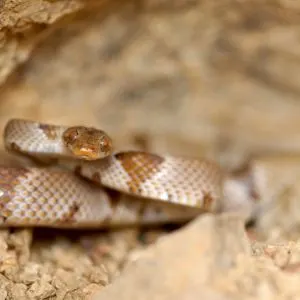
- Experience Level: Intermediate
- Family: Colubridae
- Scientific Name: Trimorphodon vilkinsonii
- Other Names: Texas Lyre Snake
- Adult Size: 30 inches
- Lifespan: 5 years
While Lyresnakes can make great pets and have an unusual look to them, they are quite feisty and can be aggressive eaters. They are also quite the escape artist, so it will take someone who knows what they’re doing to take care of them.
The Chihuahuan Lyre Snake is tan, brown, or gray with brown blotches along the top of its back which are outlined by a darker brown.
They prefer to live in rocky areas and desert climates.
They mostly feed on whiptail lizards and will overcome them and subdue them with their mild venom.
37. Slender Blind Snake

- Experience Level: Intermediate
- Family: Typhlopidae
- Scientific Name: Leptotyphlopidae
- Other Names: Threadsnake
- Adult Size: 4 to 10 inches
- Lifespan: Unknown
While you can keep these as pets, they are a very secretive species with specific care requirements. They are nocturnal beings that prefer to live underground and do not like coming out into the light, which is why we don’t know much about them.
They basically look like your typical earthworm. They might be pink, tan, light or dark brown, black, and even gray in color.
Slender blind snakes will often frequent ant burrows and termite hills where they will eat these insects as well as their eggs, pupae, and larvae.
38. New Mexico Blind Snake
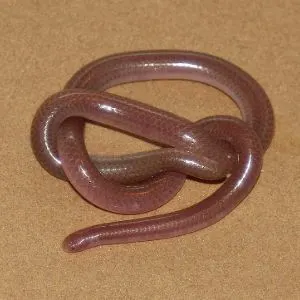
- Experience Level: Intermediate
- Family: Typhlopidae
- Scientific Name: Leptotyphlops dissectus
- Other Names: New Mexico Threadsnake
- Adult Size: 5 to 10 inches
- Lifespan: Unknown
New Mexico Blind Snakes are typically completely pink or tan in color with two tiny black dots for eyes. They look just like a worm with their blunt heads and tails.
While you can keep these as pets, they are a very secretive species with specific care requirements. They are nocturnal beings that prefer to live underground and do not like coming out into the light, which is why we don’t know much about them.
You can find them hidden in prairies, rocky or sandy deserts, and stony hillsides.
Blind snakes will often frequent ant burrows and termite hills where they will eat these insects as well as their eggs, pupae, and larvae.
39. Trans-Pecos Blind Snake

- Experience Level: Intermediate
- Family: Typhlopidae
- Scientific Name: Leptotyphlops humilis segregus
- Other Names: Western Blind Snake, Western Slender Blind Snake, Western Threadsnake
- Adult Size: 7 to 10 inches
- Lifespan: Unknown
Trans-Pecos Blind Snakes basically look like your typical earthworm, except shinier. They might be pink, tan, light or dark brown, black, and even gray in color.
They can live as deep as 66 feet underground and are known to frequent ant burrows and termite hills where they will eat these insects as well as their eggs, pupae, and larvae.
You can find them in desert or scrub areas with loose soil.
40. Lined Snake
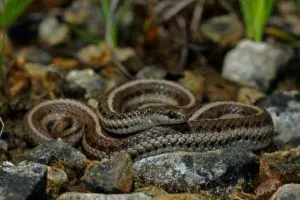
- Experience Level: Intermediate
- Family: Colubridae
- Scientific Name: Tropidoclonion
- Adult Size: 8 to 12 inches
- Lifespan: 3 to 10 years
We do not know much about Lined Snakes except that they are closely related to Garter Snakes, which help give us a little more information about these cute little critters.
These nocturnal snakes can often be found in urbanized areas, often discovered in parks, grassy areas, vacant lots, and under debris. They might also inhabit grasslands, abandoned prairies, woodland passages, oak forests, and suburban or residential areas.
They like to hide or find places to take shelter and will emit a musk if they are discovered or captured. They will rarely try to attack or bite someone.
They will often hide under leaf litter, rocks, or might burrow in the soil.
These tiny snakes basically look like mini Garter Snakes with brown or gray-brown bodies and dark stripes that can range from olive-gray to different ranges of grays.
Their undersides are cream-colored with two rows of gray blotches or spots. You may also find half-moons along their midline.
Venomous Snake Species in New Mexico
Here are some of the most venomous snakes in the state of New Mexico:
41. Western Diamondback Rattlesnake

- Experience Level: Expert
- Family: Viperidae
- Scientific Name: Crotalus atrox
- Other Names: Texas Diamondback Rattlesnake
- Adult Size: up to 5 feet
- Lifespan: 15 to 20 years
Western Diamondback Rattlesnakes are typically dusty gray or brown with some pink-brown, brick red, yellow, chalky white, or pink. They also have dark gray or brown dorsal blotches throughout their body.
They have a triangular head and are heavy-bodied. Since it is, indeed a rattlesnake, we can’t forget to mention that it has a rattle at the end of its tail! This species has black and white stripes right underneath it, too.
These guys aren’t that picky about where they live and can be found in grassy plains, forests, coastal areas, deserts, and rocky hillsides.
They feed on small mammals like prairie dogs, gophers, squirrels, rabbits, chipmunks, mice, and rats. They might also eat a bird if it comes within its reach.
42. Arizona Black Rattlesnake

- Experience Level: Expert
- Family: Viperidae
- Scientific Name: Crotalus cerberus
- Other Names: Black Rattlesnake
- Adult Size: 31 to 43 inches
- Lifespan: 12.5 years in captivity; wild lifespan unknown
Arizona Black Rattlesnakes are identified by their darker colors, sometimes being entirely black, as their name suggests. Some may also have dark brown or gray coloration outlining darker blotches on their back.
They will typically choose to live in chaparral habitats or pine-oak woodlands, where they feed on birds, mammals, and lizards.
43. Banded Rock Rattlesnake

- Experience Level: Expert
- Family: Viperidae
- Scientific Name: Crotalus lepidus klauberi
- Other Names: Green Rattlesnake, Green Rock Rattlesnake,
- Adult Size: 24 inches
- Lifespan: 30 years in captivity; wild lifespan unknown
Banded Rock Rattlesnakes are typically light gray (but may also be green or purple in some regions) with dark gray bands, making it seem like they are striped.
They like arid and semi-arid environments such as tropical deciduous forests, outcrops at high elevations, rocky flats, grasslands, and mountains.
They mostly feed on invertebrates, small mammals, lizards, birds, as well as other snakes. They use their venom to subdue their prey before gulping them up.
44. Eastern Rock Rattlesnake

- Experience Level: Expert
- Family: Viperidae
- Scientific Name: Crotalus lepidus
- Other Names: Blue Rattlesnake, Green Rattlesnake, Little Green Rattlesnake, Pink Rattlesnake, Texas Rock Rattlesnake, White Rattlesnake
- Adult Size: 32 inches
- Lifespan: 30 years
Eastern Rock Rattlesnakes are icy white or gray with brown or dark gray thin banded blotches and small brown dots in between the larger blotches.
They like arid or semi-arid climates such as tropical deciduous forests, outcrops at high elevations, rocky flats, grasslands, and mountains.
Unlike other rattlesnakes, they tend to be more active in colder temperatures.
They eat lizards, small mammals, and also frogs sometimes.
45. Black-tailed Rattlesnake

- Experience Level: Expert
- Family: Viperidae
- Scientific Name: Crotalus ornatus
- Other Names: Ornate Black-tailed Rattlesnake, Black-tailed Rattlesnake
- Adult Size: 30 to 42 inches
- Lifespan: 15 to 20 years in the wild; 17 years in captivity
Black-tailed Rattlesnakes are typically tan, light brown, or bray in color with brown or black blotches that become bands near their tail, which is completely black all the way toward their rattle.
These terrestrial snakes like to inhabit deserts, rocky mountains, grasslands, pine-oak forests, canyon sides, cave ledges, and deserts.
They are carnivores that feed on small mammals, rodents, birds, and smaller reptiles.
46. Mojave Rattlesnake

- Experience Level: Expert
- Family: Viperidae
- Scientific Name: Crotalus scutulatus scutulatus
- Other Names: Mojave Green Rattlesnake
- Adult Size: 3.3 feet
- Lifespan: 10 to 15 years
Mojave Rattlesnakes are heavy-bodied and have a large, triangular head.
They are typically brown or pale green, depending on the area they are from. They have brown blotches all over their back across their length.
This species of rattlesnake inhabits lower mountain slopes and high desert areas. They live in various environments anywhere from dry deserts to grasslands.
They like to hide in shrubbery and bushes.
These carnivores consume mainly small rodents, lizards, birds, and toads. They like to eat mice, rats, and rabbits when picking rodents.
47. Prairie Rattlesnake
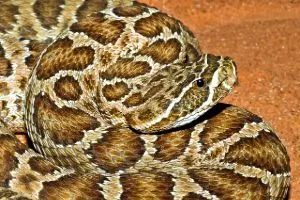
- Experience Level: Expert
- Family: Viperidae
- Scientific Name: Crotalus viridis
- Other Names: Western Rattlesnake, Great Plains Rattlesnake
- Adult Size: 5 feet
- Lifespan: 16 to 20 years in the wild; 24 years max in captivity
- Average Price Range: $100 to $200 per snake
If you suffer a bite from this viper and don’t get it treated, it can be very dangerous, and even fatal.
This venomous pit viper is a tan, hefty rattlesnake with dark brown blotches or bands along their backsides, splitting into dark olive or brown rings at their tail.
They can be spotted in sagebrush, grasslands, and high rocky ledges. Prairie Rattlesnakes mostly consume various kinds of rodents.
48. New Mexico Ridge-Nosed Rattlesnake

- Experience Level: Expert
- Family: Viperidae
- Scientific Name: Crotalus willardi obscurus
- Other Names: Ridge-Nosed Rattlesnake
- Adult Size: 2 feet
- Lifespan: 15 years
The New Mexico Ridge-Nosed Rattlesnakeis the only venomous snake that is listed as a “Threatened Species” by the U.S. Fish and Wildlife Service.
They are typically gray-brown with white or tan stripes along their backs. They also have inconsistent brown blotching or spots along each of their sides.
Their most distinctive feature has to be the prominent ridge that they have on their snout.
This species can be found in steep rocky canyons, pine-oak or pine-fir forests, among rocks, and under leaf litter.
They mainly feed on rodents, but will also eat lizards, other smaller snakes, birds, other small mammals, and centipedes.
49. Massasauga Rattlesnake
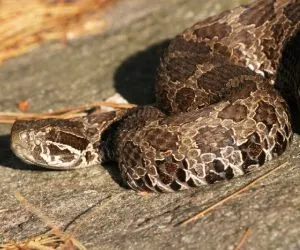
- Experience Level: Expert
- Family: Viperidae
- Scientific Name: Sistrurus catenatus
- Other Names: Eastern Massasauga, Massasauga Rattlesnake
- Adult Size: about 2 feet
- Lifespan: 14 years
The Eastern Massasauga is protected by The U.S. Fish and Wildlife Service under the Endangered Species Act. This means that they cannot be taken from the wild and are not to be messed with.
A bite from one of these vipers will not be one you will forget and could also kill you since they are one of the most venomous snakes in the United States. Although, they are quite shy creatures which is why bites don’t happen too often and are considered a rare occurrence.
The majority of their population can be found in Wisconsin as well as Ontario, and only an average of one or two bites are reported per year in these areas.
Massasaugas are tan or gray in color with bright brown blotches along their back and smaller blotchy patterns along their sides.
In the wilderness, they choose to live in open, rocky areas since these environments will allow them to bask freely with multiple options. They may also be found in deserts, forests, prairies, and marshes.
They like areas where they can take cover from bird predators and where prey is abundant. They will eat insects, lizards, smaller snakes, and amphibians but they mainly feed on smaller mammals.
When hunting, these vipers are the stalking type, sitting and waiting for their prey. They have special pits near each of their eyes that are heat-sensitive and will alert them when prey is near.
They will then inject them with a little bit of their toxic venom before swallowing them whole.
50. Sonoran Coral Snake

- Experience Level: Expert
- Family: Elapidae
- Scientific Name: Micruroides euryxanthus euryxanthus
- Other Names: Arizona Coral Snake
- Adult Size: 13 to 21 inches
- Lifespan: 18 years
Sonoran Coral Snakes are smaller than other Coral Snakes, but still has the same striking black, white, yellow, or red banding or striping that other Corals possess.
They can be found in arid and semi-arid environments like woodlands, grasslands, rocky deserts, brush, and along river bottoms.
They primarily feed on other snakes, especially Threadsnakes. They will also consume lizards. They eat only smooth-scaled reptiles.
Conclusion
We hope that this article helped you understand the laws and what snakes you might find in New Mexico.
Whether you are looking to keep one as a pet or just want to learn more out of interest, leave us a comment about your thoughts and opinions about snakes in New Mexico!
Snakes in other states

Toni Bocci
Friday 21st of October 2022
We just saw this dead snake along highway 279 mile just off the 550 IMG_5628.jpg Please ID for us. Thank you T
Snaketracks
Saturday 22nd of October 2022
@Toni Bocci, Send us an email [email protected] with the image :)